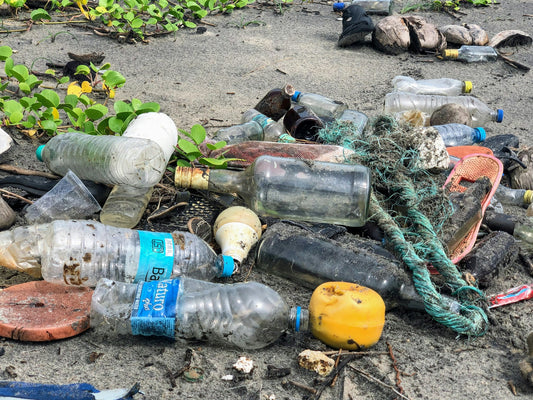Share
Want to reduce waste in your household. The kitchen is a great place to start!
These 11 simple steps will help you make an impact in no time.
Step 1: Take Inventory
Step 2: Buy in Bulk
Step 3: Say Goodbye to Plastic Bags
Step 4: Ditch the Plastic Wrap
Step 5: Choose Sustainable Cleaning Products
Step 6: Repurpose Glass Jars
Step 7: Use Reusable Or Compostable Utensils
Step 8: Compost Your Food Scraps
Step 9: Keep Your Kitchen Minimal
Step 10: Recycle Properly
Step 11: Spread the Word
--------------------------
A Step-by-Step Guide to a Zero Waste Kitchen
Are you looking to reduce your environmental footprint and live a more sustainable lifestyle?
An ideal place to start is in the kitchen. The average person generates a significant amount of plastic waste in the kitchen, from food packaging to single-use utensils.
In this step-by-step guide, we'll show you how to transform your kitchen into a zero waste haven.
Remember: Progress beats perfection. If you're overwhelmed by the amount of plastic in your life, just pick an item a month and look for a more sustainable option.
You'll be amazed how quickly you see the impact. One SWOP at a time
Step 1: Take Inventory
The first step to a zero waste kitchen is to take inventory of what you already have and what your regular waste looks like.

Analyze your household needs
First, look through your pantry, cleaning supplies, and fridge and take note of what you regularly use.
As you go through your kitchen inventory, create a list with three categories: 1. Daily, 2. Weekly, and 3. Monthly.
Note down the items that you use once at least once a day, once a week, and the items you use at least once a month.
If you want to declutter you life, it can also make sense to note down the items you use less than once a month, because they may be unnecessary and you can potentially give them away.
This exercise will help you later to identify what you can buy in bulk, which items will make the biggest impact if you replace them, and what you can maybe even make yourself.
Analyze your household waste
Once you know your needs, it is time to check your regular kitchen waste.
This helps you to confirm what you learned in the analysis of your household needs and at the same time it gives you an immediate idea where to start.
- check your compost for unnecessary food waste,
- check your mixed waste for unnecessary plastic packages,
- check your recycling waste for unnecessary items or items that could be reused/repurposed.
As you go through and continue with the steps below, always remember the order of Reduce first, Reuse what you can, and then Recycle as a last resort.
Step 2: Buy in Bulk
Now that you have an idea of your household needs and the biggest source for waste, it is time to buy in bulk.
Buying in bulk is a great way to reduce your plastic waste.
When you buy in bulk, you can use your own reusable containers or muslin bags instead of relying on single-use packaging.

Many grocery stores now offer bulk sections for items like grains, nuts, and spices, and there are dedicated zero waste stores and bulk stores that offer most items in bulk.
We recommend to start with the items you use once a week or once a month.
While the best place to start could be different for every household, the most promising items for buying in bulk are often basics like pasta, rice, grains, coffee, sugar, or salt.
Tip: we know life happens and sometimes there just isn't the time (or the nerves) to go to a bulk store just to buy pasta. If that's the case it is a totally viable solution to look out paper packaging or for the big family packs. The bigger the package, the less is your ratio of contents to packaging, which also reduces your waste.
Now that you are an expert on bulk shopping and you know which food wrapped in plastic you can replace, it is time to tackle the rest o your kitchen.
Step 3: Say Goodbye to Plastic Bags
Despite recent plastic bans, the average American still uses an incredible 300 plastic bags per year.
Plastic bags are in fact not only a major source of plastic waste in the kitchen. They also are one of the main polluters of our oceans.
Let's be real: There really isn't an excuse to still rely on plastic bags.
Keep reusable shopping bags and produce bags at your door or in your car and ditch these plastic bags for good.

These alternatives are washable and can be used over and over again.
Step 4: Ditch the Plastic Wrap
Plastic wrap is a major source of plastic waste in the kitchen. Every year, americans use enough plastic wrap to shrink wrap the whole state of Texas.
The problem with plastic wrap is: it can clog recycling machines and is rarely recycled.

Instead of using plastic wrap, try using beeswax wraps or silicone lids.
These reusable alternatives are washable and can be used over and over again.
Bonus: they also look way better than the squishy and wrinkly plastic wrap.
Step 5: Choose Sustainable Cleaning Products
Many cleaning products come in plastic packaging and contain harmful chemicals.
Instead, choose sustainable cleaning products that come in sustainable or refillable containers.
The main areas where you can make an impact are sustainable solid dishwashing soap and plastic-free cleaning tablets. Nowadays there are even plastic-free options for dishwasher tablets.

Furthermore, once you have ditched your plastic cleaner, it's time to opt for natural sponges and sponge cloths.

Rather than using those terrible yellow plastic sponges, why don't you try a funky pop up sponge made of natural cellulose.
At the same time, beautiful sponge cloths can replace your boring artificial ones and bring a beautiful touch into your kitchen.
If you want to take it to the next level, you can even make your own cleaning products using natural ingredients like vinegar and baking soda.
If you want to learn more about Zero waste cleaning and DIY recipes, check out our blog article about this topic.
Step 6: Repurpose Glass Jars
Reusing or repurposing stuff is one of the easiest ways to significantly reduce your waste.

Glass jars are a great way to store food and small items like rubber bands or pins.
Instead of buying new glass containers, try repurposing glass jars from items like pasta sauce or pickles.
These jars can be used to store food, spices, and even leftovers.
Step 7: Use Reusable Or Compostable Utensils
Are you planning a big party or barbecue? If you're planning to use single-use utensils, remember that they are a major source of plastic waste.
Instead of using plastic utensils, try using reusable utensils or those made from bamboo.
Bamboo is a fast growing and comostable resource, which is a great alternative to plastic.

Read more about 5 reasons why we love bamboo o our blog.
Step 8: Compost Your Food Scraps
Zero waste is not only about plastic. It is about being more conscious about waste and where it comes from in general.
Food waste is a major source of landfill waste. But it does not have to be, if you give your food a second life.
Instead of throwing your food scraps in the regular trash, throw them in the compost bin or compost them yourself.

Composting is a great way to reduce your environmental footprint and create nutrient-rich soil for your garden.
Step 9: Keep Your Kitchen Minimal
A zero waste kitchen is a clutter-free kitchen.
Keeping your kitchen minimal will not only reduce your waste. it will also save you money.
It is as simple as: Try to only buy what you need and use what you have.

Go grocery shopping with a proper list planning your food for the week.
This helps you to go shopping in a more targeted way and it will also help you to avoid unnecessary impulse purchases.
You will reduce your food waste and your plastic waste as a side effect.
If you see a cool new kitchen item on sale, try to resist and give yourself some time to think if you really need it.
You'll realize that in 90% of the cases, you don't.
Step 10: Recycle Properly
Recycling is an important part of a zero waste lifestyle.
Make sure you are recycling properly by checking your local recycling guidelines.
This will help you reduce your environmental footprint and keep plastic out of landfills.

Did you know that the plastic industry started recycling to mislead consumers? Find out more and how you can properly recycle in our recycling article.
Step 11: Spread the Word
Living a zero waste lifestyle is not just about reducing your own environmental footprint, it's about inspiring others to do the same.
Spread the word about your journey to a zero waste kitchen and encourage others to join you.
Trust us, you won't even have to mention it. Your friends will ask on their own, when they see your pantry full of beautiful glass jars instead of piled plastic packages.
By following these 11 steps, you can transform your kitchen into a zero waste haven.
Remember, slow and steady wins the race. Start with one SWOP at a time and before you know it, you'll be living a more sustainable lifestyle.
We hope you enjoyed this article. If you want to read more like this, make sure to check out our Blog and follow us on Instagram. If you are interested in truly sustainable products, check out our Shop.
If you want to engage in the discussion, feel free to leave a comment below.








